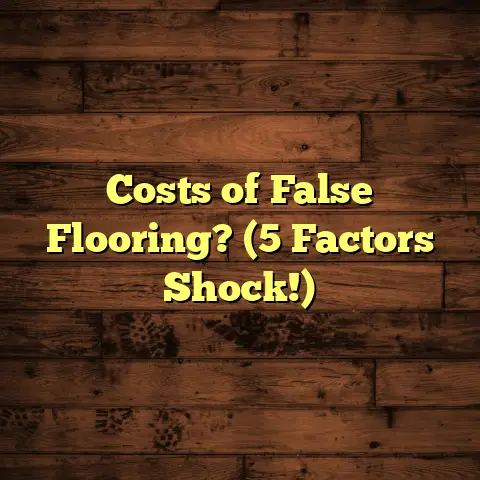Bed Bugs On Wood Floors? (3 Extermination Steps!)
Wood floors are fantastic, right? They bring warmth, style, and a touch of elegance to any space. I’ve laid down miles of hardwood, engineered wood, and laminate, and I know how much you value them. They’re durable, beautiful, and, when properly cared for, create a healthy living environment.
But what happens when those beautiful floors become a battleground for unwanted guests? I’m talking about bed bugs – those tiny, blood-sucking pests that can turn your peaceful home into a nightmare.
Trust me, I’ve seen it all. And dealing with bed bugs on wood floors is a challenge I want to help you overcome.
Let’s dive into understanding these critters, the damage they can cause, and, most importantly, how to kick them out for good!
Section 1: Understanding Bed Bugs and Their Habits
1. What Are Bed Bugs?
Okay, let’s get up close and personal with our enemy. Bed bugs (Cimex lectularius, if you want to get scientific) are small, nocturnal insects that feed on human blood.
Think of them as tiny vampires with a serious craving for your bedtime snack.
-
Physical Characteristics: Adults are about the size of an apple seed, reddish-brown, and oval-shaped. After feeding, they swell up and become more elongated and darker in color. Nymphs (baby bed bugs) are smaller and lighter in color.
-
Life Cycle: Bed bugs go through several nymph stages before reaching adulthood. They need a blood meal to molt (shed their skin) and progress to the next stage. This cycle can take weeks or months, depending on temperature and access to food (that’s you!).
-
Feeding Habits: Bed bugs are attracted to the carbon dioxide we exhale and our body heat. They typically feed at night while we sleep, piercing the skin with their mouthparts and sucking blood. The feeding process is usually painless, thanks to an anesthetic in their saliva.
-
Migration and Spread: These little hitchhikers are masters of travel. They can crawl, but they primarily spread by hitching rides on luggage, clothing, furniture, and even your shoes. In homes with wood flooring, they can easily move between rooms through cracks, crevices, and under baseboards.
- Fun Fact: Bed bugs can survive for months without feeding, making eradication a real challenge.
2. Signs of Infestation
Early detection is key to winning the war against bed bugs. The sooner you spot them, the easier it will be to get rid of them.
Here’s what to look for on and around your wood floors:
-
Visual Confirmation: This is the jackpot! Actually seeing a live bed bug is the most definitive sign. Check along seams of mattresses, in between couch cushions, and, yes, along the edges of your wood floors, especially near the baseboards.
-
Fecal Spots: These are small, dark (often black or brown) stains that look like someone dotted the floor with a marker. You’ll find them on mattresses, bedding, and, you guessed it, wood floors and baseboards.
-
Shed Skins (Exuviae): As bed bugs grow, they shed their skin. These translucent, empty shells are another telltale sign of infestation. Look for them in the same places you’d look for fecal spots.
-
Blood Stains: Small blood stains on your sheets or pillowcases can indicate bed bug activity.
-
Musty Odor: A heavy infestation can produce a distinct, musty odor. It’s not a pleasant smell, and it’s a clear sign you have a problem.
- Pro Tip: Use a flashlight to inspect dark areas and crevices. Bed bugs are nocturnal and prefer to hide during the day.
3. Why Wood Floors Are Attractive to Bed Bugs
Okay, so why are these pests so drawn to your beautiful wood floors? Here’s the lowdown:
-
Hiding Spots: Wood floors, especially older ones, often have cracks, gaps, and spaces under baseboards. These provide perfect hiding places for bed bugs, protecting them from predators and giving them easy access to their food source (that’s you again!).
-
Temperature Regulation: Wood can help regulate temperature, providing a stable environment for bed bugs to thrive.
-
Proximity to Sleeping Areas: Bed bugs want to be close to their food source. Wood floors in bedrooms and living rooms make it easy for them to crawl to your bed or couch for a midnight snack.
-
Real Talk: While bed bugs can infest any home, regardless of cleanliness, clutter can make it harder to detect and eliminate them.
-
Did You Know?: According to the National Pest Management Association, about 20% of Americans have had a bed bug infestation in their home at some point.
-
Section 2: The Impact of Bed Bugs on Wood Floors
1. Damage to Wood Floors
Let’s be clear: bed bugs don’t directly eat wood. They’re not termites. However, their presence can indirectly lead to problems:
-
Minimal Direct Damage: Bed bugs don’t bore into wood or cause structural damage like some other pests. The main issue is the mess they leave behind.
-
Indirect Issues: Fecal spots and shed skins can stain wood floors if left untreated for long periods. The constant cleaning and potential use of harsh chemicals to combat the infestation can also damage the finish of your floors.
-
Secondary Problems: In severe cases, moisture can accumulate in areas where bed bugs congregate, potentially leading to mold growth.
- Myth Buster: Bed bugs are not attracted to dirty environments per se, but clutter provides more hiding spots, making infestations harder to control.
2. Health Risks Associated with Bed Bugs
Beyond the creepy factor, bed bugs can pose real health risks:
-
Bites and Allergic Reactions: Bed bug bites can cause itchy, red welts. Some people experience severe allergic reactions, including hives and difficulty breathing.
-
Psychological Effects: Dealing with a bed bug infestation can be incredibly stressful and anxiety-inducing. It can lead to sleep deprivation, paranoia, and even social isolation.
-
Secondary Infections: Scratching bed bug bites can break the skin, leading to secondary bacterial infections.
-
Important Note: Bed bugs are not known to transmit diseases. The primary health risks are related to allergic reactions and psychological distress.
-
Personal Experience: I had a client once who was so traumatized by a bed bug infestation that they had trouble sleeping in their own home for months after the problem was resolved. It’s a serious issue!
-
Section 3: Extermination Steps
Alright, let’s get down to business. Here’s a three-step plan to evict those unwanted guests from your wood floors:
1. Step 1: Preparation
Preparation is crucial for successful bed bug extermination. It’s like prepping a canvas before painting – you need a clean slate.
-
Cleaning the Area:
- Vacuum Thoroughly: Vacuum your entire home, paying close attention to your wood floors, especially along baseboards, cracks, and crevices. Empty the vacuum bag or canister immediately into a sealed plastic bag and dispose of it outside.
- Wash and Dry: Wash all bedding, linens, curtains, and clothing in hot water (at least 120°F or 49°C) and dry on high heat for at least 30 minutes. This will kill bed bugs and their eggs.
- Steam Clean: Steam clean your mattresses, carpets, and upholstery to kill any remaining bed bugs and eggs.
-
Removing Clutter:
-
Declutter: Get rid of any unnecessary items that could provide hiding places for bed bugs. This includes books, magazines, clothing piles, and anything else that’s cluttering your floors and furniture.
- Seal and Store: Place items that can’t be washed or steamed in sealed plastic bags or containers. Consider storing them in a garage or storage unit for several months to ensure any bed bugs inside die.
-
Isolating Infested Items:
-
Bag It Up: Place infested items in sealed plastic bags to prevent bed bugs from spreading to other areas of your home.
- Dispose of Heavily Infested Items: If an item is heavily infested and difficult to treat, consider disposing of it properly. Wrap it in plastic and label it as having bed bugs to prevent others from unknowingly bringing it into their homes.
-
Protecting Belongings:
-
Mattress Encasements: Invest in bed bug-proof mattress and box spring encasements. These create a barrier that prevents bed bugs from entering or escaping.
- Furniture Covers: Consider using furniture covers to protect your upholstery from bed bugs.
-
Minimizing Disruption:
-
Communicate with Your Exterminator: Discuss the extermination process with your pest control professional and ask any questions you have.
-
Prepare for Multiple Treatments: Bed bug extermination often requires multiple treatments. Be prepared for some disruption to your daily routine.
-
Industry Secret: Diatomaceous earth (DE) is a natural powder made from fossilized algae. It can be sprinkled along baseboards and in cracks to kill bed bugs by dehydrating them. However, use food-grade DE and be careful not to inhale it, as it can irritate your lungs.
2. Step 2: Professional Extermination Methods
When it comes to bed bugs, I always recommend calling in the pros. They have the tools, knowledge, and experience to get the job done right.
Here are some common extermination methods they might use on wood floors:
-
Heat Treatment:
- How it Works: This involves heating your entire home or specific rooms to a temperature of 120-140°F (49-60°C) for several hours. Bed bugs can’t survive these high temperatures.
- Pros: Highly effective, kills bed bugs and eggs in all life stages, environmentally friendly (no chemicals).
- Cons: Can be expensive, requires careful preparation to protect heat-sensitive items, may not be suitable for all homes.
- Impact on Wood Floors: Heat treatment can potentially dry out wood floors, leading to cracking or warping. However, a reputable pest control company will monitor the temperature and humidity levels to minimize any damage.
-
Steam Cleaning:
-
How it Works: Steam cleaning uses high-temperature steam to kill bed bugs and eggs on contact. It’s particularly effective for treating mattresses, carpets, and upholstery.
- Pros: Effective for localized infestations, environmentally friendly (no chemicals), relatively inexpensive.
- Cons: May not penetrate deep into cracks and crevices, requires careful application to avoid damaging surfaces.
- Impact on Wood Floors: Steam cleaning can damage wood floors if not done properly. The moisture can cause warping and discoloration. A professional will use the appropriate steam pressure and techniques to minimize any risk.
-
Chemical Applications:
-
How it Works: This involves applying insecticides to areas where bed bugs are likely to hide, such as along baseboards, in cracks and crevices, and under furniture.
- Pros: Can be very effective, relatively inexpensive.
- Cons: Requires the use of chemicals, may not kill all eggs, can be harmful to pets and humans if not applied properly.
- Impact on Wood Floors: Some insecticides can stain or damage wood floors. A professional will use products that are specifically designed for use on wood and will take precautions to protect your floors.
-
Choosing a Pest Control Professional:
-
Licensing and Insurance: Make sure the company is licensed and insured.
- Experience: Choose a company with experience in treating bed bugs on wood floors.
- References: Ask for references from previous clients.
- Treatment Plan: Get a detailed treatment plan in writing, including the methods they will use, the number of treatments required, and any guarantees they offer.
-
Safety: Ask about the safety of the products they use and any precautions you need to take.
-
Insider Tip: Don’t be afraid to get multiple quotes from different pest control companies. Prices and treatment plans can vary significantly.
3. Step 3: Post-Extermination Follow-Up
The battle isn’t over just because the exterminator has left. Follow-up is essential to ensure those bed bugs are gone for good.
-
Monitoring for Signs of Bed Bugs:
- Continue to Inspect: Regularly inspect your wood floors, mattresses, and furniture for any signs of bed bugs, such as live bugs, fecal spots, or shed skins.
- Use Bed Bug Monitors: Place bed bug monitors under the legs of your bed and furniture to trap any remaining bed bugs.
-
Implementing Preventive Measures:
-
Regular Cleaning: Vacuum your wood floors regularly, paying close attention to baseboards and crevices.
- Seal Cracks and Crevices: Seal any cracks and crevices in your wood floors and walls to eliminate potential hiding places for bed bugs.
- Be Careful When Traveling: Inspect your luggage and clothing carefully when you return from a trip to avoid bringing bed bugs home with you.
- Inspect Secondhand Furniture: Inspect secondhand furniture carefully before bringing it into your home.
-
Timeline for Results:
-
Expect Multiple Treatments: Bed bug extermination often requires multiple treatments, spaced several weeks apart.
- Follow-Up Inspections: Schedule follow-up inspections with your pest control professional to ensure the infestation is completely eradicated.
-
Handling a Resurgence:
-
Contact Your Exterminator: If you see signs of bed bugs after the initial treatment, contact your pest control professional immediately.
-
Repeat Treatment: They may need to repeat the treatment or use a different method to eliminate the remaining bed bugs.
-
Real Talk: Bed bug extermination can be a long and frustrating process. Don’t get discouraged if you don’t see results immediately. Persistence is key!
Conclusion
So, there you have it – a comprehensive guide to dealing with bed bugs on wood floors. Remember, wood floors are a valuable asset to your home, adding beauty and comfort. But they can also be a haven for unwanted pests like bed bugs.
By understanding bed bug habits, recognizing the signs of infestation, and following the three extermination steps I’ve outlined, you can protect your floors and your health.
Don’t hesitate to take action if you suspect a bed bug problem. Early detection and prompt treatment are essential for successful eradication. And remember, calling in a professional is often the best way to ensure those pesky critters are gone for good.
Good luck, and may your wood floors be bed bug-free!





